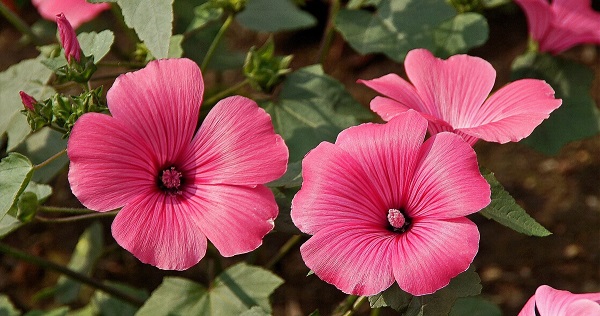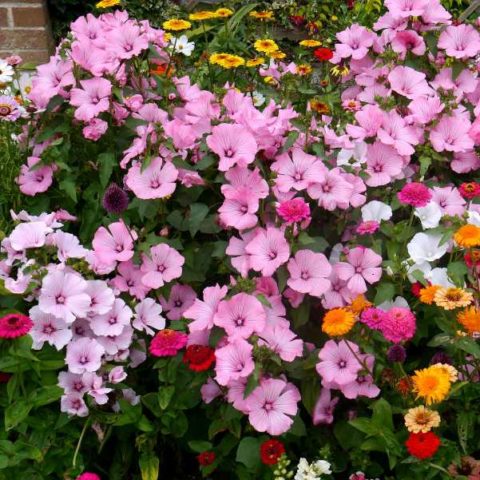Content
Lavatera perennial is one of the large flowering shrubs that is loved by experienced gardeners and beginners alike. The plant produces lush flowers of various shades. The culture is unpretentious in care and can even take root on its own from seeds scattered in the fall.
General description of perennial lavatera
Lavatera (wild rose, khatma) is a perennial plant with beautiful flowers. The name was given in honor of the Swiss naturalists the Lavater brothers, who carried out scientific activities in Zurich.
The plant is a perennial bush with powerful branches up to 1.5-2 m in height. The flowers of perennial lavatera are regular in shape, symmetrical, 8-10 cm in diameter. The corolla is five-leaved, i.e. consists of 5 identical petals. The khama flower can be painted in beautiful, attractive colors:
- light pink;
- white;
- rich pink;
- delicate lilac.

Often, perennial lavatera flowers have a pattern on the petals in the form of darker stripes
The leaves are green, with a gray tint, and can be round or heart-shaped. They have a small fluff. The root of perennial lavatera is very powerful - it goes into the ground up to 1.5 meters. Therefore, perennial lavatera confidently survives drought.
Varieties of perennial lavatera with photos
The most common type of Lavatera is the Thuringian Lavatera. This is a tall and tall shrub (up to 2 meters) with fairly large flowers (diameter up to 10 cm) of a soft pink hue. Flowering is long - from July to early September. Along with this variety, others are grown in Russia and Ukraine, for example, Burgundy Wine, Laidak Dezhi, Bregon Springs.

Lavatera Thuringiana is interesting for its unusual flowers with five symmetrical petals in the shape of hearts
Burgundy Vine
This variety of garden hat (lavatera) is distinguished by small flowers (up to 7 cm in diameter) of a rich pink color. They have darker veins running in rays from the center. It reaches a height of 180 cm. It is recommended to plant the crop in an open, well-lit area. The perennial Lavatera variety Burgundy Vine can withstand winter frosts down to -23 °C. Therefore, seedlings can be grown only in some regions of the Central part and throughout the south.

With proper care, the perennial Lavatera Burgundy Vine will bloom luxuriantly throughout the second half of summer.
Ay Catcher
This variety decorates the garden with attractive flowers of coral and pink shades. Also prefers bright, well-lit places. It is advisable to plant in an area protected from drafts.

Numerous veins are visible on the petals of IKacher, radiating from the center of the flower
Lilac Lady
Lavatera Lilac Lady is a perennial with soft lilac flowers. Veins with darker shades are also noticeable on the petals.The peculiarity of this plant is that it does not require careful care. Therefore, the variety can be grown even with minimal gardening skills.

The flowers of this variety of perennial lavatera are quite large, with a soft lilac color.
Bregon Springs
This variety of perennial lavatera decorates the garden with flowers of light lilac and delicate purple colors. A bush of medium height (up to 130 cm) with strong, dense branches and dark green foliage. It has good drought resistance. At the same time, for the winter, like many other varieties, it should be covered with a layer of foliage, straw, and spruce branches.

Beautiful Bregon Springs flowers of pastel lilac color can become the hallmark of any garden
Barnsley Baby
This is a perennial lavatera with white and light pink flowers up to 10 cm in diameter. The bush is quite compact and low - only 60-80 cm. This plant looks good both in single plantings and in compositions with ornamental grasses, sage, catnip and other flowers .

Barnsley Baby has gorgeous flowers in light shades with an interesting pink eye in the center, against which the green leaves look good
Application in landscape design
Since perennial lavatera is a very tall plant (on average 1.5 meters), it looks good in single plantings. Bushes are planted in open areas, near the entrance to the house, near a garden bench, not far from the gazebo and other recreation areas.
The bush is also used in other ways. It is appropriate to plant it:
- along a fence or road;
- in flower beds and in complex flower arrangements.
Almost all flowers are combined with perennial lavatera. The main thing is that they are not too low, otherwise the plants will be lost against the background of a tall bush.It is also necessary to choose the right color combination: for example, white with pink, lilac with red.

Often, perennial lavatera is planted in street flowerpots and placed along the road

A flower bed made of snow-white lavatera resembles a carpet

A flower bed made of snow-white lavatera resembles a carpet
Features of reproduction
The perennial Lavatera reproduces in shifts that freely spread throughout the surrounding area. As a rule, they take root well without outside help, which is why a new flowerbed may appear the next season.
Therefore, in the fall you need to watch the plant especially carefully. The seeds ripen in capsules that are first green in color and then turn brown and fall to the ground. To ensure their maturity, you need to open one box. If the seeds fall out freely, it means they are ripe. They can be collected and stored at home.
.
Planting and caring for perennial lavatera in open ground
There are two ways to grow perennial lavatera: by sowing seeds in pots or directly in open ground.
In the first case, the bushes will have time to grow and produce powerful branches; in the second, they will also take root, but will not gain as much green mass. If it is not possible to grow seedlings, then sowing in open ground is a very convenient option.
Recommended timing
Seeds of perennial lavatera are planted in such a way that in mid-May the seedlings are transferred to open ground. Since they usually grow within 60-70 days, it is advisable to sow them in early March.In the south, the timing is slightly different: at the end of February they plant seeds, and transfer the seedlings to the flower garden at the end of April.
When planting seed directly into the ground, you must wait until the threat of frost has passed. This usually happens in the middle or even at the end of May. In the south you can plant earlier - at the end of April or at the beginning of May.
Growing from seeds in seedlings
Seeds are planted in peat tablets, boxes or plastic cups. The soil can be purchased in a store or selected independently, for example, mix garden soil with the same amount of peat and disinfect the mixture in a weak solution of potassium permanganate (leave overnight).

The first shoots of perennial lavatera appear after 7-10 days
Planting algorithm:
- Seeds of perennial lavatera are pickled in potassium permanganate.
- Expanded clay or other drainage is placed at the bottom of the container.
The first shoots of perennial lavatera appear after 7-10 days
- Cover the soil.
- Moisten with a spray bottle.
- Seeds are planted to a depth of 1 cm (2-3 pieces in each pot).
- Cover with glass and grow in a greenhouse at room temperature.
Ventilate regularly. Illuminated with a phytolamp so that the total length of the day is at least 12 hours.
After the second pair of leaves appears, the plant is pruned. In this case, the root must be shortened by a third of its length so that the lavatera gains green mass.
Sowing directly into the ground
When planting seeds of perennial lavatera in the ground, the area needs to be dug up. If the soil is depleted, add rotted manure or complex mineral fertilizer.Then plant the seeds according to the standard pattern: 20 cm between seedlings and 25 cm between rows. At first, it is recommended to cover with film. You will also need to moisten the soil in time and periodically ventilate the greenhouse.
Features of care
Perennial lavatera does not require special care; it is enough to follow these rules:
- water as needed: in hot weather once a week; if it rains, additional moisture is not needed;
- apply fertilizer twice - nitrogen or complex fertilizer before planting seedlings, as well as a mixture of equal amounts of potassium sulfate and sodium sulfate in mid-July, when abundant flowering begins;
- periodically loosen the soil;
- After planting, it is better to immediately mulch the roots so that the soil remains moist for as long as possible.
The perennial Lavatera produces numerous lush flowers even with minimal care.
Wintering
Perennial lavatera overwinters in open ground. It tolerates frost quite well, but some varieties are not so winter-hardy. For example, Burgundy Vine can withstand frosts down to -23 °C, so it will not be possible to grow it in Siberia and the Urals.
Even in the central part of Russia and the South, the plant must be prepared for winter:
- At the end of summer and in September there is no need to feed perennial lavatera. Instead, give abundant watering.
- Remove all faded petals.
- The branches are cut or carefully bent to the ground and secured with rope.
- A structure made of boards is installed on top.
- Sprinkle with dry leaves, spruce branches, straw.
- Cover with agrofibre or burlap.

In the spring, at the end of March, the covering must be removed, since the foliage may rot
This is especially true for the southern regions, where noticeable thaws begin at this time.
Diseases and pests
Many gardeners note that perennial lavatera is resistant to pests and diseases. However, it is susceptible to a fungal disease - rust. The pathology can be determined by its external sign - brown spots form on the leaves.
Any fungicide (Topaz, Fitosporin, Tattu, Bordeaux mixture and others) is used for treatment. You can also use folk remedies:
- 400 g of fresh celandine greens (or 100 g of dry raw materials) are poured into 1 liter of water, brought to a boil and simmered over low heat for 0.5 hours, then allowed to cool and sprayed on the foliage;
- 2 tablespoons of tobacco leaves (dried) are also poured into 1 liter of water, left for 2 days, filtered and brought to a total volume of 2 liters, then the crown is also sprayed.
Conclusion
Lavatera perennial is one of the large garden shrubs that decorate the garden with lush flowering. The culture is not capricious in terms of care, but varieties can differ greatly in winter hardiness. Therefore, before purchasing seeds, it is important to clarify the possibility of growing a bush in a particular region.











